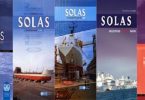SAFETY CONSTRUCTION SURVEY CHECKLIST
| Name of Ship: | IMO Number: | Flag: | Port of Registry: |
| Assignment No: | Port of Survey: | Date Survey Commenced: | Date Survey Completed: |
| Date of last dry-docking survey:
Carried out by (organization): |
Date of last tail shaft survey: Carried out by (organization): |
||
Notes:
- Complete relevant sections as applicable for the surveys carried out. Mark boxes ‘Y’ to indicate YES, ‘N‘ to indicate NO and “-“ to indicate NOT APPLICABLE.
- Complete Sections A, B, C and D (if applicable) for all surveys. In addition, complete section E for renewal/periodical surveys. For first time survey by IS, complete section F in addition to the relevant sections as applicable for the surveys being carried out.
A |
GENERAL |
|||||||||||||||||||||||||
| 1 | Have any changes been made or any new equipment installed which would affect the validity of the Cargo Ship Safety Construction Certificate? If YES, provide details on page 7) | | ||||||||||||||||||||||||
| 2 | Were all other statutory and Classification certificates valid at the time of survey? | | ||||||||||||||||||||||||
| 3 | Are all surveys up-to-date? (Periodical surveys for boilers and pressure vessels, dry-docking and tail shaft surveys, periodical survey of the automation and/or remote controls for the main propulsion, periodical surveys for inert gas systems etc) – (SAFCON certificates should not be issued or endorsed in cases where surveys/recommendations are overdue and postponement has not been agreed by HO) | | ||||||||||||||||||||||||
| 4 |
Status of certificates:
|
|||||||||||||||||||||||||
A |
GENERAL |
|
| 5 | The log entries record that the following have been checked or tested and found satisfactory within 12 hours before departure from any port: | |
| 5.1 | Steering gear – The tests included, where applicable, the operation of the main steering gear, the auxiliary steering gear, remote control systems, bridge steering position, emergency power supply, rudder angle indicators, steering gear system power unit failure alarms, automatic isolating arrangements and other alarms | |
| 5.2 | Communication system – bridge to steering gear compartment | |
| 5.3 | Full movement of the rudder | |
| 5.4 | Visual inspection of the steering gear linkage | |
| 6 | The log entries record that emergency steering drills have been carried out every three months | |
| 7 | The change over diagrams of steering gear are posted | |
| 8 | All officers are reportedly familiar with steering gear change-over procedures | |
| 9 | The approved loading / stability information is on board | |
| 10 | For ships assigned timber loadlines, the approved timber deck cargo loading and lashing plan is on board | |
| 11 | The approved cargo securing manual is on board (for ships carrying cargoes other than solid or liquid bulk cargo) | |
| 12 | The required ESP documentation (copies of required drawings, survey reports, thickness measurements reports etc) for Oil Tankers (including combination carriers) and Dry Bulk cargo ships (Bulk Carriers) is on board. | |
| 13 | Maneuvering booklet with the necessary information is available / displayed on the bridge. For dry cargo ships built after 1st February 1992, the damage control plan is available on board | |
B |
HULL SURVEYS |
|
| 1 | Hull and its closing appliances, so far as can be seen, have been generally examined and found satisfactory. Weather decks, hatchways, vents and air pipes; casings, skylights, flush deck scuttles, deckhouses and companionways; superstructures, side, bow and stern doors; windows, side scuttles and dead lights; chutes and other openings; scuppers, sanitary discharges and valves; guardrails and bulwarks; freeing ports, gangways, walkways and lifelines | |
| 2 | Flame screens on vents/air pipes at all fuel oil tanks are satisfactory as far as could be seen. | |
| 3 | Anchoring and mooring equipment has been examined as far as practicable and found in satisfactory condition | |
| 4 | All watertight doors in watertight bulkheads have been examined and tested as far as practicable and found in satisfactory condition | |
B |
HULL SURVEYS |
|
| 5 | Penetrations in watertight bulkheads have been examined as far as practicable and found in satisfactory condition | |
| 6 | The arrangement for structural fire protection has been checked and remains unchanged (any alterations to be reported) | |
| 7 | Manual and/or automatic fire doors, where fitted, have been examined and found in satisfactory condition | |
| 8 | The operation of the loading instrument, where fitted, has been verified. (The loading instrument program must be approved) | |
| 9 | Hatch covers and coamings have been examined and tested and found weather tight. Satisfactory operations of mechanically operated hatch covers have been verified. | |
| 10 | Cargo holds and salt-water ballast tanks have been examined internally to the extent possible and found in satisfactory condition. | |
| 11 | Thickness measurements have been carried out (if required by surveyor) by approved firm and copies of report has been placed on board and a copy has been forwarded to Head Office | |
| 12 | For ships with special arrangements (ramps, bow/stern/side doors, container securing arrangements etc), the condition of the special arrangements is satisfactory as far as could be seen. | |
13
Leave a Comment | ||


